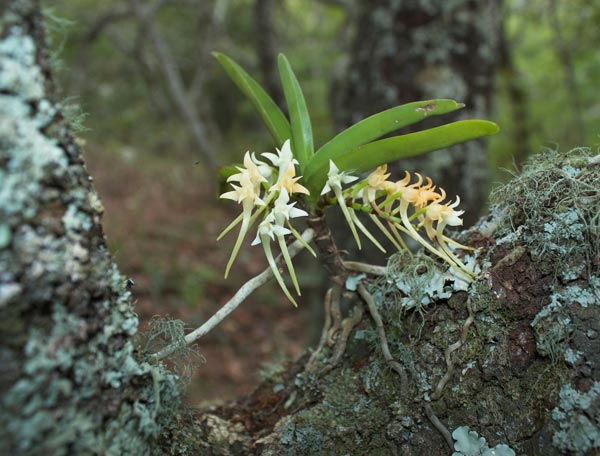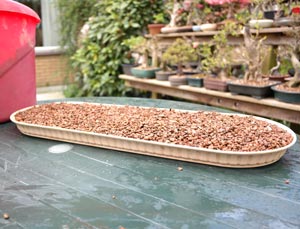

If you're ever lucky enough to visit a rainforest, you might be surprised how familiar the plants there all are. Cheese plants, mother-in-law's tongue, and bromeliads are everywhere. These plants thrive in the intense heat and moisture of the jungle. But when we keep these plants in our homes, they tend to do just fine. They simply don't need the same levels of temperature and humidity as their wild cousins. In fact many are the easiest houseplants to care for. Care for orchids indoors is also really quite simple, though we have to treat them a little differently to other rainforest houseplants. They occupy a different environmental niche in their natural habitat, and remembering this is critical when we are looking after orchids in our homes.
But people have been keeping orchids in their homes for hundreds of years. There are very many varieties of orchid that have adapted to typical indoor conditions and as long as a few basic rules are followed, make excellent, easy to care for houseplants.
 An orchid growing epiphytically in Chimanimani, eastern Zimbabwe. Photo Brian Gratwicke
An orchid growing epiphytically in Chimanimani, eastern Zimbabwe. Photo Brian GratwickeThere are over 30000 recognised species of orchid, and thousands more cultivars (hybrids). But for the purposes of this article, we are considering the main epiphytic species (and their hybrids) kept as houseplants: Phalaenopsis, Dendrobium, Cattleya, Vanda etc. You may have seen the word epiphyte before, and simply glossed over it. But take a minute to comprehend... understanding the meaning of this word can be the difference between a flourishing orchid and a dead orchid!
An epiphyte is a plant that grows on another plant. It does not take moisture or nutrients from the host plant, it merely uses it as a surface on which to grow. In general, orchids will grow on a tree branch, in a well ventilated spot some meters above ground level. So what does this mean in practise?
Obviously every home is different. But in general houses have more consistent temperatures than gardens and greenhouses. There is a variation in temperature between day and night (diurnal variation), but this is usually greater outside, than in our heavily insulated, temperature controlled homes.
Humidity can also be quite low indoors, again especially in places with continual heating. Orchid growers in the northern hemisphere are likely to have windows closed and heating on for much of the year. This creates a naturally dry atmosphere, quite distinct from the rainforests our orchids are used to.
Light levels may be lower or higher than in the rainforest, depending on your geographical location, the facing of your windows, and the proximity of your orchid to them.
At the beginning of this article, I made a big deal about the epiphytic nature of most orchids. But in the home, care for potted orchids does not (usually) include a host plant. Sure, we treat the roots as if they were growing on a branch, but instead we grow them in a pot. And this is where most uninformed orchid owners go wrong. Because they are purchased in a pot, they give the illusion of being terrestrial rather than epiphytic. In fact orchids tend to be 'planted' in lumps of bark (usually from fir trees). To the roots, this is a little like holding onto a tree, and importantly, their somewhat loose packing allows ventilation within the pot. A bark-potted orchid is a good approximation of growing epiphytically on a branch.
 credit
credit
If the air in your home is too hot and dry for your orchids to thrive, you can increase the humidity by using a “pebble dish”. Fill a shallow dish or tray with pebbles and add water. Keep the waterline right below the top of the pebbles. Place the orchid pot on top of the pebbles where it can enjoy the slowly evaporating water. It is very important not to overfill the pebble dish with water, since the bottom of the orchid pot should never be in touch with water. If the orchid roots are allowed to actually reach the water, they will deteriorate.

If you decide to use a pebble dish, proper orchid care will involve cleaning the pebbles carefully every 2-3 month. Remove the pebbles and clean them using a mild bleach solution. This will prevent algae growth. It is not recommended to add algaecide to the water that you fill up the dish with; regularly cleaning the pebbles is much better.
The biggest contrast between a tropical rainforest environment, and the one we provide in our homes is in humidity. The relative humidity of a rainforest is often around 70-80%, compared to just around 30-40% in a typical home. The humidity can drop to 10-15% in cold weather when windows are closed and central heating is in use. The moisture levels in kitchens and bathrooms may be slightly higher, especially when in use, but still incomparable to an orchids natural environment.
Essential moisture has to come from regular watering, but without being wet. The bark chip planting media absorbs a small amount of moisture, but doesn't get waterlogged in the same way soil can. Drainage is increased by providing a pot with side-holes or slots. Even though the plant is 'potted', it is well ventilated, and incapable of holding much water.
Raising room humidity is not really appropriate in a house, at least not to the level it can be raised in a greenhouse for example. Orchids can be misted of course, but the best way to permanently increase the moisture around your orchids is to keep them over a pebble dish, or a commercially bought humidity tray.
### pseudobulbsThe roots of epiphytes, especially those higher up trees, have strong air circulation. Although they regularly get a soaking they are very often dry. And even equatorial rainforests have wet and dry seasons. Despite the intense humidity, orchids can often struggle to find sufficient moisture, underlining the importance of the pseudobulb 'stores'. Care for potted orchids indoors replicates the situation experienced attached to a tree outside, by ensuring the roots always have good access to air. Orchid pots are typically slotted, or have numerous holes drilled (or melted) into the sides. Aswell as increasing drainage, this lets air into the pot. If you purchase an orchid without this it is very much worth changing to a pot with better ventilation. The use of bark (or similar) as a potting media is also essential. Although it holds a little moisture, it has numerous air spaces around it. As the bark breaks down (over a couple years) it can get more compacted, so regular repotting is important, to keep the roots aerobic.
The majority of orchids kept indoors come from tropical or sub tropical forests. Indoor temperatures, depending on where in the world you live, are not too dissimilar. Homes in northern areas may have slightly cooler ambient temperatures, but most hardy hybrids adapt easily to a range of conditions. The Amazon, for example, has temperature ranges of 75-90°F (24-32°C) in summer and 74-82°F (23-28°C) in winter. Of course not all orchids are the same. Species that live at higher altitudes often experience cooler winter conditions. A good example is the soft-cane Dendrobium nobile type orchids that live in the foothills of the Himalayas. These plants regular experience winter temperatures as low as 50°F (10°C). A level that most homes do not drop to. Of course being kept a little warmer will not kill the plant, however usually a period of significantly lower temperature is essential to initiate flowering the following season. If such species are kept, a cool period (maybe two to three weeks) outside in autumn might do the trick.
Of course, our homes are typically not uniformly heated. Even modern, well-insulated properties have rooms with regularly open windows or no radiators. Older homes often have drafty window sills. Characteristics like these can influence the decision of where to keep your orchid.
 Care for orchids indoors is easy if you have good light, good root ventilation, and don't over water. Photo Maja Dumat
Care for orchids indoors is easy if you have good light, good root ventilation, and don't over water. Photo Maja DumatLight is critical for all plants. Although too little light won't kill your orchids in the same way too much water will, too little light will prevent your orchid from flowering. Good lighting is perhaps the biggest challenge when keeping an orchid indoors, and is one reason why low-light species like Phalaenopsis are so popular. 'Low light', as a term is perhaps misleading. It means low levels of direct sunlight. The orchid will still do best in a bright position. Typically near a window, though behind a net curtain if midday sun shines directly through.
Lighting is an important issue for orchids, and one that is not always easy to get right. Orchids living in trees experience different lighting levels depending on the foliage around them. Those higher up get more light than those lower down. In evergreen environments, like rainforests, lighting levels will continually change over time. There is no telling what light levels the plant could experience. Trees fall, opening up shaded areas to bright light. New growth constantly replacing the old. Jungle orchids can often tolerate low light conditions, but they do far better more. But orchids in deciduous forests do have more predictable lighting. Dendrobium nobile mentioned above experiences much brighter winters than summers. The leaves of the trees around it have fallen, and without their shade, the orchids experience nothing but bright Himalayan sunlight. Orchids are clearly adaptable in the wild, and this gives us the opportunity to experiment when choosing a place for them in our homes.
Direct sunlight on an orchids leaves can cause serious burning. The leaf yellows, and may even turn black in the burnt section. This situation is exacerbated in our homes because of the dryer atmospheres. Plants continually loose water through their leaves: a process called transpiration. This has a cooling effect. As long as the plant has access to moisture, it can keep transpiring and keep cool. In the heat of a tropical orchid habitat, this is no problem. In our homes it is. An unexpected day of warm weather can cause some quite visible damage. If this happens you should reposition your plant or install a net curtain. Keeping plants over a humidity tray can help, as can regular mistings in hot weather.
Insufficient light will result in deep green leaves. Perhaps more to the point it will prevent flowering. If your home is just too dark for orchids, lighting can be supplemented with LED grow lights. These are really useful in darker spots in the home, and because LED lighting doesn't produce significant heat, they won't easily burn leaves (as long as they don't touch!) and are not too expensive to run.